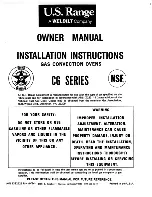
Uses, Tables and Tips
26
Frozen Ready Meals Table
Roasting
Oven function: Conventional
or Rotitherm
Roasting dishes
•
Any heat-resistant ovenware is suitable to use for roasting (please read the manufac-
turer's instructions).
•
Large roasting joints can be roasted
directly in the roasting tray or on the oven
shelf with the roasting tray placed below it.
•
For all lean meats, we recommend
roasting these in a roasting tin with a lid.
This
will keep the meat more succulent.
•
All types of meat, that can be browned or have crackling, can be roasted in the
roast-
ing tin without the lid
.
3
Tips on using the roasting chart
The information given in the following table is for guidance only.
•
We recommend cooking meat and fish
weighing 1 kg and above in the oven
.
•
To prevent escaping meat juices or fat from burning on to the pan, we recommend
placing some liquid in the roasting pan.
•
If required, turn the roast (after 1/2 - 2/3 of the cooking time).
•
Baste large roasts and poultry with their juices several times during roasting. This will
give better roasting results.
•
You can switch the oven off about 10 minutes before the end of the roasting time, in
order to utilise the residual heat.
Food to be
cooked
Oven function
Shelf
position
Temperature
°C
Time
Frozen pizza
Conventional
3
as per manufac-
turer’s instruc-
tions
as per manufac-
turer’s instruc-
tions
Chips
1)
(500 g)
1) Comments: Turn chips 2 or 3 times during cooking
True fan
3
200-220
as per manufac-
turer’s instruc-
tions
Baguettes
Conventional
3
as per manufac-
turer’s instruc-
tions
as per manufac-
turer’s instruc-
tions
Fruit flans
Conventional
3
as per manufac-
turer’s instruc-
tions
as per manufac-
turer’s instruc-
tions
















































